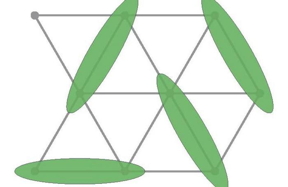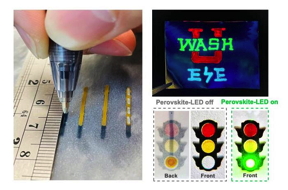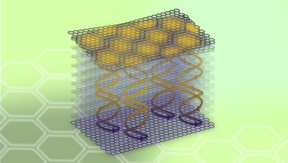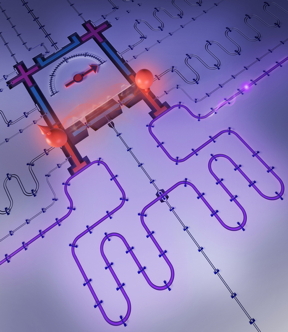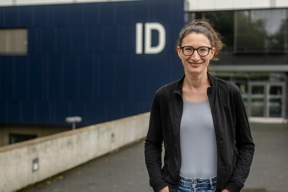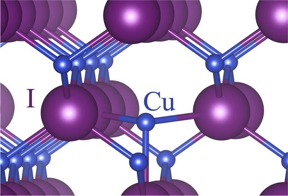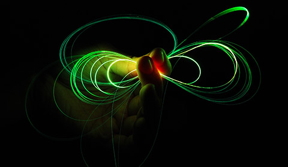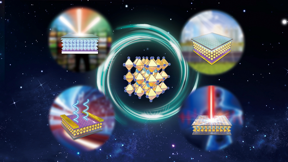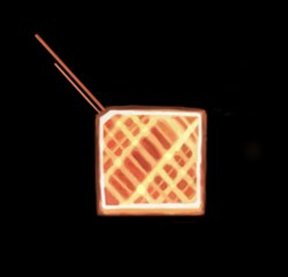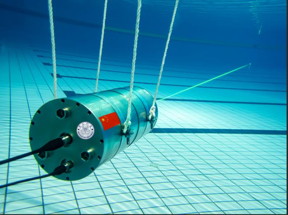Home > Press > Progress toward fast-charging lithium-metal batteries: By growing uniform lithium crystals on a surprising surface, UC San Diego engineers open a new door to fast-charging lithium-metal batteries
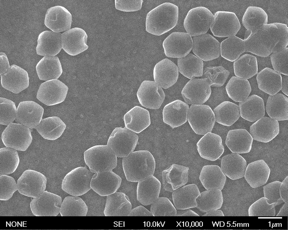 |
| In this SEM image, large, uniform crystals of lithium metal grow on a surface that is surprising because it doesn’t “like” lithium. UC San Diego battery researchers found that lithium metal crystals can be started (nucleated) and grown, quickly and uniformly, into dense layers of lithium metal that lack performance-degrading dendrites. In a Nature Energy paper published on Feb. 9, 2023, the UC San Diego battery researchers showed that this surprise formation of lithium crystal seeds leads to dense lithium layers even at high charging rates, resulting in long-cycle-life lithium-metal batteries that can also be fast charged. This discovery overcomes a common phenomena in rechargeable lithium-metal batteries in which high-rate charging always leads to porous lithium and short cycle lifes. By replacing the ubiquitous copper surfaces on the negative side (the anode) of lithium-metal batteries with this lithiophobic surface made of lithium fluoride and iron, the researchers have opened a new avenue for creating more reliable, safer, higher performance lithium-metal batteries. CREDIT Zhaohui Wu and Zeyu Hui / UC San Diego |
Abstract:
In a new Nature Energy paper, engineers report progress toward lithium-metal batteries that charge fast – as fast as an hour. This fast charging is thanks to lithium metal crystals that can be seeded and grown – quickly and uniformly – on a surprising surface. The trick is to use a crystal growing surface that lithium officially doesn’t “like.” From these seed crystals grow dense layers of uniform lithium metal. Uniform layers of lithium metal are of great interest to battery researchers because they lack battery-performance-degrading spikes called dendrites. The formation of these dendrites in battery anodes is a longstanding roadblock to fast-charging ultra-energy-dense lithium-metal batteries.
Progress toward fast-charging lithium-metal batteries: By growing uniform lithium crystals on a surprising surface, UC San Diego engineers open a new door to fast-charging lithium-metal batteries
San Diego, CA | Posted on February 10th, 2023
This new approach, led by University of California San Diego engineers, enables charging of lithium-metal batteries in about an hour, a speed that is competitive against today’s lithium-ion batteries. The UC San Diego engineers, in collaboration with UC Irvine imaging researchers, published this advance aimed at developing fast-charging lithium-metal batteries on Feb. 9, 2023 in Nature Energy.
To grow lithium metal crystals, the researchers replaced the ubiquitous copper surfaces on the negative side (the anode) of lithium-metal batteries with a lithiophobic nanocomposite surface made of lithium fluoride (LiF) and iron (Fe). Using this lithiophobic surface for lithium deposition, lithium crystal seeds formed, and from these seeds grew dense lithium layers – even at high charging rates. The result was long-cycle-life lithium-metal batteries that can be charged quickly.
“The special nanocomposite surface is the discovery,” said UC San Diego nanoengineering professor Ping Liu, the senior author on the new paper. “We challenged the traditional notion of what kind of surface is needed to grow lithium crystals. The prevailing wisdom is that lithium grows better on surfaces that it likes, surfaces that are lithiophilic. In this work, we show that is not always true. The substrate we use does not like lithium. However, it provides abundant nucleation sites along with fast surface lithium movement. These two factors lead to the growth of these beautiful crystals. This is a nice example of a scientific insight solving a technical problem.”
The new advance led by UC San Diego nanoengineers could eliminate a significant roadblock that is holding back widespread use of energy-dense lithium-metal batteries for applications like electric vehicles (EVs) and portable electronics. While lithium-metal batteries hold great potential for EVs and portable electronics because of their high charge density, today’s lithium-metal batteries must be charged extremely slowly in order to maintain battery performance and avoid safety problems. The slow charging is necessary to minimize the formation of battery-performance-wrecking lithium dendrites that form as lithium ions join with electrons to form lithium crystals on the anode side of the battery. Lithium crystals build up as the battery charges, and the lithium crystals dissolve as the battery discharges.
Ping Liu is the director of the Sustainable Power and Energy Center (SPEC) at the UC San Diego Jacobs School of Engineering where he also serves as professor in the Department of NanoEngineering.
####
For more information, please click here
Contacts:
Daniel Kane
University of California – San Diego
Office: 858-534-3262
Copyright © University of California – San Diego
If you have a comment, please Contact us.
Issuers of news releases, not 7th Wave, Inc. or Nanotechnology Now, are solely responsible for the accuracy of the content.
| Related Links |
| Related News Press |
News and information
![]() Graphene Flagship start-up Bedimensional closes a second €10 million investment round February 10th, 2023
Graphene Flagship start-up Bedimensional closes a second €10 million investment round February 10th, 2023
![]() Make them thin enough, and antiferroelectric materials become ferroelectric February 10th, 2023
Make them thin enough, and antiferroelectric materials become ferroelectric February 10th, 2023
![]() Scientists reveal the effect of Cu(I) structure on quantum sieving for hydrogen isotope separation February 10th, 2023
Scientists reveal the effect of Cu(I) structure on quantum sieving for hydrogen isotope separation February 10th, 2023
Govt.-Legislation/Regulation/Funding/Policy
![]() Graphene Flagship start-up Bedimensional closes a second €10 million investment round February 10th, 2023
Graphene Flagship start-up Bedimensional closes a second €10 million investment round February 10th, 2023
![]() Novel microscope developed to design better high-performance batteries: Innovation gives researchers inside view of how batteries work February 10th, 2023
Novel microscope developed to design better high-performance batteries: Innovation gives researchers inside view of how batteries work February 10th, 2023
![]() Make them thin enough, and antiferroelectric materials become ferroelectric February 10th, 2023
Make them thin enough, and antiferroelectric materials become ferroelectric February 10th, 2023
Possible Futures
![]() Make them thin enough, and antiferroelectric materials become ferroelectric February 10th, 2023
Make them thin enough, and antiferroelectric materials become ferroelectric February 10th, 2023
![]() Scientists reveal the effect of Cu(I) structure on quantum sieving for hydrogen isotope separation February 10th, 2023
Scientists reveal the effect of Cu(I) structure on quantum sieving for hydrogen isotope separation February 10th, 2023
Discoveries
![]() Make them thin enough, and antiferroelectric materials become ferroelectric February 10th, 2023
Make them thin enough, and antiferroelectric materials become ferroelectric February 10th, 2023
![]() Scientists reveal the effect of Cu(I) structure on quantum sieving for hydrogen isotope separation February 10th, 2023
Scientists reveal the effect of Cu(I) structure on quantum sieving for hydrogen isotope separation February 10th, 2023
Announcements
![]() Graphene Flagship start-up Bedimensional closes a second €10 million investment round February 10th, 2023
Graphene Flagship start-up Bedimensional closes a second €10 million investment round February 10th, 2023
![]() Fiber sensing scientists invent 3D printed fiber microprobe for measuring in vivo biomechanical properties of tissue and even single cell February 10th, 2023
Fiber sensing scientists invent 3D printed fiber microprobe for measuring in vivo biomechanical properties of tissue and even single cell February 10th, 2023
![]() Photonic Materials: Recent Advances and Emerging Applications February 10th, 2023
Photonic Materials: Recent Advances and Emerging Applications February 10th, 2023
![]() Make them thin enough, and antiferroelectric materials become ferroelectric February 10th, 2023
Make them thin enough, and antiferroelectric materials become ferroelectric February 10th, 2023
Interviews/Book Reviews/Essays/Reports/Podcasts/Journals/White papers/Posters
![]() Make them thin enough, and antiferroelectric materials become ferroelectric February 10th, 2023
Make them thin enough, and antiferroelectric materials become ferroelectric February 10th, 2023
![]() Scientists reveal the effect of Cu(I) structure on quantum sieving for hydrogen isotope separation February 10th, 2023
Scientists reveal the effect of Cu(I) structure on quantum sieving for hydrogen isotope separation February 10th, 2023
Automotive/Transportation
![]() Novel microscope developed to design better high-performance batteries: Innovation gives researchers inside view of how batteries work February 10th, 2023
Novel microscope developed to design better high-performance batteries: Innovation gives researchers inside view of how batteries work February 10th, 2023
![]() UC Irvine researchers decipher atomic-scale imperfections in lithium-ion batteries: Team used super high-resolution microscopy enhanced by deep machine learning January 27th, 2023
UC Irvine researchers decipher atomic-scale imperfections in lithium-ion batteries: Team used super high-resolution microscopy enhanced by deep machine learning January 27th, 2023
![]() New nanowire sensors are the next step in the Internet of Things January 6th, 2023
New nanowire sensors are the next step in the Internet of Things January 6th, 2023
- SEO Powered Content & PR Distribution. Get Amplified Today.
- Platoblockchain. Web3 Metaverse Intelligence. Knowledge Amplified. Access Here.
- Source: http://www.nanotech-now.com/news.cgi?story_id=57298
- 10
- 2023
- 27th
- 3d
- 9
- a
- About
- accuracy
- accurate
- Achieve
- advance
- advances
- against
- always
- and
- applications
- approach
- author
- Avenue
- back
- Bandwidth
- batteries
- battery
- beautiful
- because
- become
- Better
- boost
- broad
- build
- CA
- california
- called
- Center
- CGI
- challenged
- charge
- charged
- charges
- charging
- Closes
- collaboration
- COM
- comment
- Common
- competitive
- content
- Copper
- could
- Creating
- credit
- Crystal
- cycle
- Decipher
- deep
- density
- Department
- Design
- developed
- developing
- Diego
- Director
- discover
- discovery
- Door
- effect
- Electric
- electric vehicles
- Electronics
- electrons
- eliminate
- emerging
- enables
- energy
- Engineering
- Engineers
- enhanced
- enough
- Ether (ETH)
- Even
- example
- extremely
- factors
- FAST
- fast-charging
- faster
- Fe
- February
- flagship
- form
- formation
- formed
- found
- Frequency
- from
- gif
- gives
- great
- Grow
- Growing
- grown
- Grows
- Growth
- High
- high-performance
- high-resolution
- higher
- hold
- holding
- How
- However
- hydrogen
- image
- Imaging
- in
- Inc.
- information
- Innovation
- insight
- interest
- Internet
- investment
- IT
- January
- join
- Kind
- Lack
- large
- layers
- lead
- Leads
- Led
- links
- lithium
- machine
- made
- maintain
- material
- materials
- measuring
- metal
- Microscope
- Microscopy
- million
- more
- movement
- nanotechnology
- Nature
- necessary
- needed
- negative
- net
- New
- news
- next
- Noise
- Notion
- Officially
- open
- opened
- optimal
- order
- Paper
- performance
- PHP
- ping
- plato
- Plato Data Intelligence
- PlatoData
- please
- Post
- posted
- potential
- power
- Problem
- problems
- Professor
- Progress
- promising
- properties
- provides
- published
- Quantum
- quickly
- Rates
- recent
- reducing
- Releases
- reliable
- replaced
- report
- researchers
- responsible
- result
- resulting
- return
- reveal
- safer
- Safety
- Said
- San
- San Diego
- Save
- School
- School of Engineering
- scientists
- Search
- Second
- secondary
- seed
- seeds
- senior
- sensors
- serves
- Share
- Short
- show
- signals
- significant
- single
- Sites
- slow
- Slowly
- Solving
- special
- speed
- spikes
- start
- Start-up
- started
- Step
- structure
- submit
- Super
- Surface
- surprise
- surprising
- sustainable
- system
- team
- Technical
- The
- their
- to
- today
- today’s
- toward
- traditional
- true
- ubiquitous
- university
- University of California
- us
- use
- Vehicles
- View
- vivo
- Wave
- What
- which
- while
- widespread
- wisdom
- Work
- wu
- Yahoo
- zephyrnet










